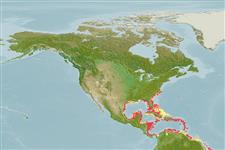Common names from other countries
Classification / Names / Names
Common names | Synonyms | Catalog of Fishes (gen., sp.) | ITIS | CoL | WoRMS
Environment: milieu / climate zone / depth range / distribution range
Ecology
Sessile; depth range 5 - 15 m (Ref. 108813). Tropical
Western Central Atlantic: USA and Caribbean wide.
Length at first maturity / Size / Weight / Age
Maturity: Lm ? range ? - ? cm
Massive amorphous to cake shaped. Surface with round low elevations. Large oscules: 0.8 - 1.5 cm wide and small oscules; 0.1 - 0.2cm wide aggregated. Compressible but dense in consistency (Ref. 415). May be roughly globular. Surface is smooth and non-porous, with clusters of pore sieves. External and internal color: black, charcoal or dark gray. External often covered with pale sediment and algal turf (Ref. 85482).
Common on hard, inshore, shallow bottoms and on seagrass beds; less common on shallow reefs. Internal canal system supports an abundance and diverse invertebrate fauna. Known from depths between 0.5 to about 18 m (Ref. 85482).
Life cycle and mating behavior
Maturity | Reproduction | Spawning | Eggs | Fecundity | Larvae
Members of the class Demospongiae are hermaphroditic. Life cycle: The zygote develops into parenchymella larva (free-swimming) before settling down on a substrate where it grows into a young sponge.
Collin, R., M.C. Díaz, J. Norenburg, R.M. Rocha, J.A. Sánchez, M. Schulze, A. Schwartz and A. Valdés. 2005. (Ref. 415)
IUCN Red List Status (Ref. 130435)
CITES status (Ref. 108899)
Not Evaluated
Not Evaluated
Human uses
| FishSource |
Tools
More information
Age/SizeGrowthLength-weightLength-lengthMorphologyLarvaeAbundance
Internet sources
Estimates based on models
Preferred temperature
(Ref.
115969): 23.7 - 28.3, mean 27.1 (based on 403 cells).
Price category
Unknown.
